Peking University
Peking University (Chinese: 北京大学, informally Beida 北大, PKU; lit. "Beijing University"), is a major research university in Beijing, China, and a member of the elite C9 League of Chinese universities.[5] Peking University was established as the Imperial University of Peking in 1898 by the Guangxu Emperor when it received its first royal charter. A successor of the older Guozijian Imperial College,[6] the university's romanized name 'Peking' retains the older transliteration of 'Beijing' that has been superseded in most other contexts.[7] Perennially ranked as one of the top academic institutions in China and the world,[8][9] as of 2021, PKU is ranked 2nd in the Asia-Pacific and emerging countries by Times Higher Education, and 23rd in the world.[10][11][12]
北京大学 | |
 | |
Former names | Imperial University of Peking[1] |
|---|---|
Motto in English | Ensuring quality and pursuing excellence[2] |
| Type | Public |
| Established | 1898 |
| President | Hao Ping |
| Council Chair | Qiu Shuiping |
Academic staff | 11,337[3] |
| Students | 44,729[3] |
| Undergraduates | 16,058[3] |
| Postgraduates | 28,671[3] |
| Location | , China 39°59′23″N 116°18′19″E |
| Campus | Urban, 274 ha (680 acres)[4] |
| Colours | Red |
| Affiliations | IARU, AALAU, AEARU, APRU, BESETOHA, C9, McDonnell International Scholars Academy |
| Website | www |
 | |
| Peking University | |||||||||||||
|---|---|---|---|---|---|---|---|---|---|---|---|---|---|
| Simplified Chinese | 北京大学 | ||||||||||||
| Traditional Chinese | 北京大學 | ||||||||||||
| |||||||||||||
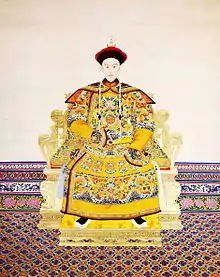
Throughout its history, PKU has had an important role "at the center of major intellectual movements" in China.[13] Abolished of its status as a royal institution after the fall of the Qing dynasty and the Xinhai Revolution; from the early 1920s, the university became a center for China's emerging, progressive, and republican movements. Faculty and students held important roles in originating the New Culture Movement, the May Fourth Movement protests, and other significant cultural and sociopolitical events, to the extent that the university's history has been closely tied to that of modern China. Peking University has educated and hosted many prominent modern Chinese figures, including Mao Zedong, Lu Xun, Gu Hongming, Hu Shih, Mao Dun, Li Dazhao, Chen Duxiu, and current Premier Li Keqiang.[14]
Peking University's library is one of the largest libraries in the world, containing over 8 million volumes.[15] The university also operates the PKU Hall, a professional performing arts center, and the Arthur M. Sackler Museum of Arts and Archaeology. PKU is also renowned for its campus grounds and the beauty of its traditional Chinese architecture.[16][17][18][19] Additionally, it hosts one of the only undergraduate liberal arts colleges in Asia, and is a Class A institution under the Chinese Double First Class University program.[20] Peking University's alumni and staff include 76 members of the Chinese Academy of Sciences, 19 members of the Chinese Academy of Engineering and 25 members of the World Academy of Sciences.[21]
History


Establishment
Following China's defeat in the Sino-Japanese War, intellectuals - including Kang Youwei, Liang Qichao, and Yan Fu - called for reforms to the country's education system. In June 1896, Minister Li Duanfen proposed to create a university in the capital. On 11 June 1898, the Guangxu Emperor, as part of the Hundred Days' Reform, authorised the creation of the Imperial University of Peking[22] (simplified Chinese: 京师大学堂; traditional Chinese: 京師大學堂; pinyin: Jīngshī Dàxuétáng; lit. 'Capital Grand Study Hall').[23] The Imperial University was formally established on 3 July 1898 when the emperor approved the royal charter written by Liang. Minister Sun Jianai was charged with the implementation. IUP served as the country's foremost institute for higher learning, but also as its highest educational authority.[22] William Alexander Parsons Martin was the first President.[23] Most of the reforms were abolished when the conservative Empress Dowager Cixi seized power on 21 September. The university survived with altered objectives and reduced scope. It opened on 31 December with 160 students, instead of the planned 500.[22]
In 1900, the university was paralyzed by the Boxer Rebellion, later in the year, the "Eight-Power Allied Forces" (八国联军) entered Beijing and the university's operating was continually suspended. In 1902, "Jingshitongwenguan", a school established by the Qing court in 1862 for foreign language learning was incorporated into the Imperial University of Peking. In 1904, the university sent 47 students to study abroad, which marked the first time for Chinese higher education institution to send students to foreign countries.
Following the Xinhai Revolution, the Imperial University of Peking was renamed "Government University of Peking" in 1912 and then "National University of Peking" in 1919[23] (simplified Chinese: 国立北京大学; traditional Chinese: 國立北京大學; pinyin: Guólì Běijīng Dàxué).
Early Republic of China period (1916–1927)
The noted scholar Cai Yuanpei was appointed president on January 4, 1917, and helped transform Peking University into the country's largest institution of higher learning, with 14 departments and an enrollment of more than 2,000 students. President Cai, inspired by the German model of academic freedom, introduced faculty governance and democratic management to the university. Cai recruited an intellectually diverse faculty that included some of the most prominent figures in the progressive New Culture Movement, including Hu Shih, Liu Bannong, Ma Yinchu, Li Dazhao, Chen Duxiu, Lu Xun and Liang Shuming. Meanwhile, leading conservatives Gu Hongming and Huang Kan also taught at the university.[24] A firm supporter for freedom of thought, Cai advocated for educational independence and resigned several times protesting the government's policy and interference.
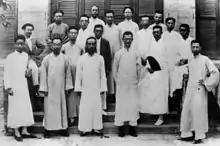

.jpg.webp)
On May 1, 1919, some students of Peking University learned that the Treaty of Versailles would allow Japan to receive Germany's colonising rights in Shandong province. An assembly at Peking University that included these students and representatives from other universities in Beijing was quickly organised. On May 4, students from thirteen universities marched to Tiananmen to protest the terms of Treaty of Versailles, demanded the Beiyang government to refuse to sign the treaty. Demonstrators also demanded the immediate resignation of three officials: Cao Rulin, Minister of the Ministry of Transportation, Zhang Zongxiang, China's Ambassador to Japan and Lu Zongyu, Minister of Currency, who they believed were in cooperation with Japanese. The protest ended up with some protesters being beaten and arrested, and Cao Rulin's house burned by protesters. Following the protest on May 4, students, workers and merchants from nearly all China's major cities went on strike and boycotted Japanese goods in China. The Beiyang government eventually agreed to release the arrested students and fired the three officials under intense public pressure, China's representatives in Paris refused to sign the Treaty of Versailles.[25]
These protests, now known as the May Fourth Movement, has been widely regarded as one of the most important turning points in modern China's history. In its broader sense, the May Fourth Movement led to the establishment of radical Chinese intellectuals who went on to mobilize peasants and workers into the Communist party and gain the organizational strength that would solidify the success of the Communist Revolution.
Following the May Fourth Movement, Chen Duxiu and Li Dazhao cofounded the Communist Party of China, and Chen served as its first general secretary. Both Chen and Li served as faculty for Peking. Li served as a head librarian, and Chen served as Peking University's dean.
In 1920, Peking University became the first Chinese university to accept female students.
World War II (1927–1949)
After the outbreak of the Second Sino-Japanese War in 1937 and the resulting expansion of Japanese territorial control in east China, Peking University was relocated to the southwestern city of Changsha and formed the Changsha Temporary University along with nearby schools Tsinghua University and Nankai University. In 1938, the three schools moved again, this time further southwest to Kunming, and formed the National Southwestern Associated University.
In 1946, after the Japanese surrender in World War II, Peking University moved back to Beijing. At that time, the university comprised six schools (Arts, Science, Law, Medicine, Engineering, and Agriculture), and a research institute for humanities. The total student enrollment grew up to 3,000.
People's Republic of China (1949–present)
In 1949, after the People's Republic of China was established, Peking University lost its "national" appellation to reflect the fact that all universities under the new socialist state would be public. In 1952, Mao Zedong's government re-grouped the country's higher education institutions with individual institutions tending to specialize in a certain field of study after the Soviet model. As a result, some arts and science faculties of Tsinghua University and former Yenching University were merged into Peking University. At the same time, however, the university lost its Law, Medicine, Engineering and Agriculture schools. These schools and faculties were either merged into other universities or to found new colleges. During the re-grouping, Yenching University was closed up. Peking University moved from downtown Beijing to the former Yenching campus.
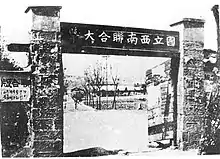

The first disturbances of the Cultural Revolution began at Peking University in 1966; education there ceased between 1966 and 1970.
On May 4, 1998, at the 100th anniversary of Peking University, Communist Party General Secretary Jiang Zemin announced that the government would initiate a national project to promote China's higher education by funding selected universities to achieve world-class level. The project was later named “985” based on the date of its announcement.
In 2000, Beijing Medical University was merged back into Peking University and became the Peking University Health Science Campus. Beijing Medical University, which used to be Medical School of Peking University, was separated from Peking University in 1952. Peking University now has eight affiliated hospitals and 12 teaching hospitals.
In 2001, Peking University established the Yuanpei Program. It was formalized in 2007 as the Yuanpei College, named in honor of the highly respected former university president Cai Yuanpei. The college hosts an elite undergraduate liberal arts program that allows students to freely choose specialisations. In the same year, Peking University set up a satellite campus for graduate students in Shenzhen. The university's second business school, Peking University HSBC Business School was launched on the Shenzhen campus in 2004.
In 2014, Peking University established the Yenching Academy, a fully funded global fellowship program designed "to cultivate leaders who will advocate for global progress and cultural understanding."
In October 2015, Peking University alumni Professor Tu Youyou was awarded the Nobel Prize in Physiology or Medicine for her discovery of artemisinin. Having saved millions of lives, artemisinin has made significant contributions to global health in regard to the fight against malaria.[26]
On February 20, 2017, Peking University officially signed a contract with The Open University to establish the Oxford Campus of Peking University's HSBC business school, marking a turning point for the development of China's higher education.[27]
Campus
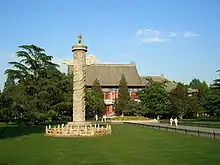
The campus of Peking University was originally located northeast of the Forbidden City in the center of Beijing, and was later moved to the former campus of Yenching University in 1952. The main campus is in northwest Beijing, in Haidian district, near the Summer Palace and the Old Summer Palace; the area is traditionally where many of Beijing's most renowned gardens and palaces were built.
The university campus is on the former site of Qing Dynasty imperial gardens and it retains much traditional Chinese-style landscaping, including traditional houses, gardens, pagodas, and many notable historical buildings and structures. The landscape in campus gives a presentation of western styles combined with traditional Chinese aesthetic standards. American architect and art historian Talbot Hamlin designed some of the university's buildings constructed during the 1919 to 1922 period.[28] There are several gates that lead into campus — East, West and South gates, with the West Gate being the most well known for the painted murals on its ceiling. Weiming Lake is in the north of the campus and is surrounded by walking paths and small gardens. The university hosts many museums, such as the Museum of University History and the Arthur M. Sackler Museum of Art and Archaeology.[29][30] Notable items in these museums include funerary objects that were excavated in Beijing and date back thousands of years from the graves of royals of the Warring States period. There are ritual pottery vessels as well as elaborate pieces of jewelry on display. There are also human bones set up in the traditional burial style of that period.[30]
Beyond its main campus, Peking University Health Science Center (PKUHSC) is on Xueyuan Road where the country's most distinguished colleges are, and is a fitting site for academics and research.
In 2001, Peking University's Shenzhen campus, the Shenzhen Graduate School, opened its doors. The campus is located in the northwest part of Shenzhen City.
 Peking University during winter. The campus is situated on a former imperial garden.
Peking University during winter. The campus is situated on a former imperial garden.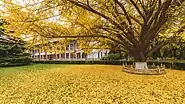 Peking University during the autumn. The campus is covered in gold.
Peking University during the autumn. The campus is covered in gold.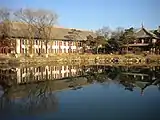 The College of Architecture and Landscape
The College of Architecture and Landscape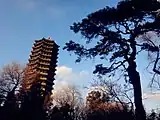 Boya Pagoda by Weiming lake
Boya Pagoda by Weiming lake The Humanities Buildings
The Humanities Buildings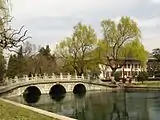 A stone bridge inside the campus
A stone bridge inside the campus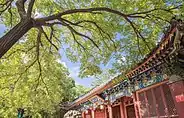 Peking University West Gate
Peking University West Gate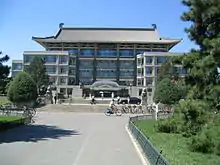 Peking University's Main Library
Peking University's Main Library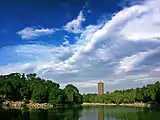 Weiming Lake occupies the central part of the campus of Peking University
Weiming Lake occupies the central part of the campus of Peking University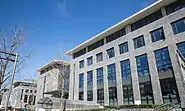 Peking University's Science Teaching Building
Peking University's Science Teaching Building School of International Studies
School of International Studies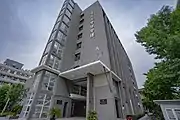 College of Chemistry and Molecular Engineering
College of Chemistry and Molecular Engineering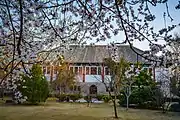 Peking University during the spring. Flowers are blooming everywhere.
Peking University during the spring. Flowers are blooming everywhere.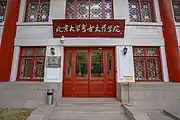 School of Archaeology and Museology
School of Archaeology and Museology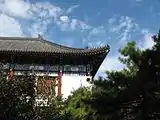 Arthur M. Sackler Museum of Arts and Archaeology
Arthur M. Sackler Museum of Arts and Archaeology Department of History
Department of History School of Life Sciences
School of Life Sciences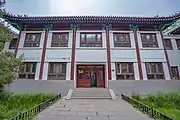 Beijing International Center for Mathematical Research
Beijing International Center for Mathematical Research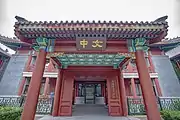 Department of Chinese Language and Literature
Department of Chinese Language and Literature
Academics
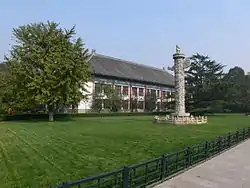
Peking University consists of 30 schools and 12 departments, with 125 majors for undergraduates, 2 majors for the second Bachelor's degree, 282 programs for Master's degree candidates and 258 programs for doctoral candidates. In addition to basic research, the university also conducts applied research.[31]
At present, Peking University has 216 research institutions and research centres, including 2 national engineering research centers, 81 key national disciplines, and 12 national key laboratories. With 8 million holdings, the university library is the largest of its kind in Asia.[32]
Peking University, the Georgia Institute of Technology, and Emory University jointly administer the Wallace H. Coulter Department of Biomedical Engineering.[33][34] Peking University has become a center for teaching and research, consisting of diverse branches of learning such as pure and applied sciences, social sciences and humanities, and sciences of management and education.
Over the past century, some Peking University alumni have become presidents of other major Chinese universities, including former Tsinghua President Luo Jialun, Renmin University President Yuan Baohua, Zhejiang University President Qian Sanqiang, Fudan University President Zhang Zhirang, Nankai University President Teng Weizao, Chinese University of Science and Technology President Guan Weiyan and many others.[35]
Rankings and Reputation
| University rankings | |
|---|---|
| Global – Overall | |
| ARWU World[36] | 49 |
| QS World[37] | 22 |
| QS Employability[38] | 19 |
| THE World[39] | 23 |
| THE Reputation[40] | 16 |
| Regional – Overall | |
| QS Asia[41] | 5 |
| QS BRICS[42] | 2 |
| THE Asia[43] | 2 |
| THE Emerging Economies[44] | 2 |
| National – Overall | |
| BCUR National[45] | 2 |
Many domestic rankings have placed Peking University among the top universities in mainland China.[46] In 2015, the Chinese University Alumni Association[47] in partnership with China Education Center considered it first among all Chinese universities.[46]
Peking had topped the newly launched Times Higher Education BRICS & Emerging Economies since its inception in 2014 before it lost that top spot to Tsinghua in 2019.[48][49] In 2018, Peking University was ranked 1st in China, 2nd in Asia-Pacific, and 27th in the world according to the Times Higher Education World University Rankings.[50] In the QS Graduate Employability Rankings 2017, an annual ranking of university graduates' employability, PKU was ranked 11th in the world.[51] Peking University was among the top 20 most reputation universities in the world by the Times Higher Education World Reputation Rankings where, since 2017, it has ranked 17th globally.[52]
The 2020 CWTS Leiden Ranking ranked Peking University at 8th in the world based on their publications for the time period 2015–2018.[53] For the high quality of research in natural science and life science, Peking University ranked 10th among the leading institutions globally in the Nature Index 2020 Annual Tables by Nature Research.[54] In 2020, it ranked 13th among the universities around the world by SCImago Institutions Rankings.[55]
The Times Higher Education World University Rankings 2021 ranked Peking University 23rd in the world and 2nd in China & Asia-Pacific, with its teaching and research performance indicators placed at 8th and 13th globally, which are historical strengths for the university.[56][57] The U.S. News & World Report ranked Peking University 51st in the world, 5th in Asia and 2nd in China.[58] QS World University Rankings ranked Peking University 23rd in the world and 5th in Asia.[59] Peking University was also ranked 15th in the world and 1st in Asia in the The Three University Missions Ranking.[60] Academic Ranking of World Universities, also known as the "Shanghai Ranking", placed Peking University 49th in the world, 4th in Asia, and 2nd in China.[61] The Research Base of Beijing Science and Technology Innovation Center also placed Peking University 2nd in China,[62] demonstrating the academic and research prowess of the University.
Schools and Institutes
| Faculty of Sciences | |||
| School of Mathematical Sciences | School of Physics | College of Chemistry and Molecular Engineering | School of Life Sciences |
| College of Urban and Environmental Sciences | School of Earth and Space Sciences | School of Psychological and Cognitive Sciences | College of Architecture and Landscape Architecture |
| Faculty of Information and Engineering | |||
| School of Electronics Engineering and Computer Science | College of Engineering | Institute of Computer Science and Technology | School of Software and Microelectronics |
| College of Environmental Sciences and Engineering | National Engineering Research Center for Software Engineering* | ||
| Faculty of Humanities | |||
| Department of Chinese Language and Literature* | Department of History | School of Archaeology and Museology | Department of Philosophy, and of Religious Studies |
| School of Foreign Languages | School of Arts | School of Chinese as a Second Language | Academy of Opera |
| Faculty of Social Sciences | |||
| School of International Studies | Law School | Department of Information Management | Department of Sociology |
| School of Government | School of Marxism | Graduate School of Education | School of Journalism and Communication |
| Department of PE | School of New Media* | ||
| Faculty of Economics and Management | |||
| School of Economics | Guanghua School of Management | Institute of Population Research | National School of Development |
| Peking University Health Science Center | |||
| School of Basic Medical Sciences | School of Pharmaceutical Sciences | School of Public Health | School of Nursing |
| Institute of Medical Humanities/School of Foundational Education Health Science Center | School of Continuing Medical Education* | Peking University First Hospital | Peking University People's Hospital |
| Peking University Third Hospital | Peking University Hospital of Stomatology | Peking University Sixth Hospital | Peking University Cancer Hospital |
| Peking University Shenzhen Hospital | Peking University Shougang Hospital | ||
| Interdisciplinary | |||
| Yuanpei College (undergraduate liberal arts) | Yenching Academy | Advanced Technology Institute | Academy for Advanced Interdisciplinary Studies |
| Institute of Social Science Survey | Institute of Molecular Medicine | The Kavli Institute for Astronomy and Astrophysics | Institute of Nuclear Sciences and Technology |
| Beijing International Center for Mathematical Research | Institute of Ocean Research* | School of Advanced Agricultural Sciences | Institute of Humanities and Social Sciences |
| Shenzhen Graduate School | |||
| School of Electronic and Computer Engineering | School of Chemical Biology and Biotechnology | School of Environment and Energy* | School of Urban Planning and Design |
| School of Advanced Materials | HSBC Business School | School of Transnational Law | School of Humanities and Social Sciences |
Peking University Library
The Peking University Library has always strived towards: “Open Inclusiveness, Cultural Inheritance, Innovative Services, and Harmonious Development.”[63] The Library aims to become a modern world-class library with state-of-the-art facilities, modern technology, and ample resources for the students. With these goals in mind, the library hopes to build Peking University into a world-class university.
The Library has developed through many stages over these past hundred years. The Library is constantly evolving, expanding its collections and improving the facilities and equipment. With its new historical-yet-modern exterior, the Peking University Library is one of the most representative buildings on campus. It is also widely known as one of the most significant libraries in the country.
The Peking University Library chronicles the very life of Peking University, from the dedicated staff, to the perseverance of the students. It shall record the proud achievements in its books, and also compel us to continue our dream-chasing efforts.[64]
Culture

Peking University is well known for its contribution to modern Chinese literature, poetry and art, and for the publication of groundbreaking modern Chinese books such as Hong Zicheng's A History of Contemporary Chinese Literature.[65]
Peking University has participated in many joint art-research projects, such as the Center for the Art of East Asia (CAEA) with the University of Chicago,[66] and Department of Digital Art and Design with UNESCO.[67][68]
Peking University partners with Stanford University for its Asian cultural studies programs such as the Stanford Program in Beijing and the Stanford-Peking University Summer Program, which encourages Stanford students interested in exploring Chinese language, history, culture, and society to study on campus at Peking University.[69]
National School of Development (NSD)
The National School of Development (formerly China Center for Economic Research) is ranked amongst the top five most influential think tanks in China.[70]
In 1998, Justin Yifu Lin et al. jointly founded the Beijing International MBA at Peking University (BiMBA),[71] which is ranked among the top six MBA programs by Quacquarelli Symonds in its TopMBA ranking of the best MBA programs in Asia Pacific for the year 2014–2015.[72] BiMBA has also been ranked as the second most valuable full-time MBA in China by Forbes (after CEIBS)[73] and among Asia's best business schools by Bloomberg Business.[74][75]
Peking University Shenzhen Graduate School
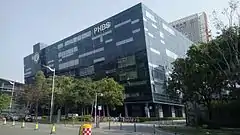
Peking University Shenzhen Graduate School is a satellite campus of Peking University located in Shenzhen, Guangdong. It was founded in September, 2001 in collaboration with the Shenzhen Municipal Government and is located in University Town of Shenzhen along with satellite campuses of Tsinghua University and Harbin Institute of Technology. Dr. Wen Hai, a renowned economist in China and the vice-president of Peking University is the present chancellor of PKU Shenzhen.[76] The school houses seven research departments as well as the Peking University HSBC Business School and Peking University School of Transnational Law.[77]
On August 29, 2016, Peking University signed a strategic agreement with the Shenzhen Municipal Government to further develop its Shenzhen Graduate School, the university plans build a brand new campus near the existed graduate school and open undergraduate programs.[78]
International students
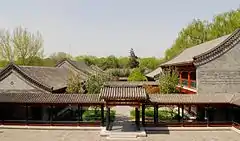
Every year, there are approximately 7,000 international students studying at Peking University.[79] The dormitories for international students at the main campus are located at Shaoyuan Garden (勺园) and Zhongguanyuan Global Village (中关新园). Its international students are made up of students from most countries in the world including most of Western Europe, North America, and South America, Asia, Australia, and many countries in Africa.
In 2005, Peking University and Cornell University signed an agreement formally establishing[80][81] the China and Asia-Pacific Studies major[82] at Cornell, which requires students to spend a semester studying at Peking University while working at internships. In 2006, PKU launched a joint undergraduate program with Yale University[83][84] in which students will spend a semester overseas, living and studying together with the host institute's students.[84] PKU's School of International Studies also launched joint degree programs with London School of Economics, Paris School of International Affairs,[85] Waseda University, Seoul National University, and the University of Tokyo. PKU also has a longstanding relationship with Stanford University which operates a joint research center and base for Stanford students and scholars at the Stanford Center at Peking University, located in the Lee Jung Sen Building.[86] The Peking University HSBC Business School has joint degree programs with University of Hong Kong and Chinese University of Hong Kong.
The university has maintained a partnership with the Freie Universität Berlin since 1981 and the Higher School of Economics since 2015, and in 2019, became a partner of Washington University of St. Louis through the McDonnell International Scholars Academy.[87][88]
Global Excellence Strategy
On the 121st founding anniversary, Peking University unveiled the "Global Excellence Strategy", an international blueprint aiming to enhance Peking University’s global presence during the "Fourth Industrial Revolution". The "Global Excellence Strategy" aims to strengthen international cooperation, overcome development barriers, gather global resources, and stimulate collegial relationships. The Global Excellence Strategy is based upon the English word "CLOUDS", representing the "cloud era" of the "Fourth Industrial Revolution". Each letter stands for a corresponding word, namely creativity, leadership, openness, uniqueness, diversity and shaping.[89]
Notable people
Notable alumni
According to CUAA's 2015 ranking of notable alumni in politics, Peking University has produced the most notable politicians among all universities in China.[90] As of 2017, 88 Peking University alumni currently serve in the government at vice-ministerial positions or higher.[91] Notable alumni include two of the seven member Standing Committee of the CPC, current premier of China Li Keqiang,[92] current vice premier of China Hu Chunhua,[93] current Secretary of the Central Commission for Discipline Inspection, Zhao Leji, and former minister of commerce, Bo Xilai.[94]
Notable alumni in the sciences include Nobel laureate Tu Youyou, who for her work in discovering artemisinin and dihydroartemisinin used to treat malaria, was awarded the Nobel Prize in Physiology or Medicine jointly with William C. Campbell and Satoshi Ōmura;[95] nuclear physicists and contributors to Chinese nuclear weapons program Qian Sanqiang and Deng Jiaxian, and "father of the Chinese hydrogen bomb" physicist Yu Min, nuclear physicist Zhu Guangya, particle physicist and discoverer of the partial conservation of the axial current, Zhou Guangzhao; mathematician and MacArthur Fellow Yitang Zhang,[96] neurosurgeon Wang Zhongcheng, pulmonologist and recipient of the Medal of the Republic, Zhong Nanshan,[97] and chief economist of the World Bank, Justin Yifu Lin.[98]
Notable alumni in the arts include author Lu Xun, philosopher and essayist Hu Shih,[99] polymath Lin Yutang, philosopher Liang Shuming, Qing-dynasty educator Gu Hongming, anthropologist Fei Xiaotong, translator Li Bulou, computer scientist Wang Xuan, and author Jin Yong.[100] Notable international alumni include emeritus professor and linguist Michael Halliday,[101] author Julia Ebner,[102] and polymath and fellow of the Royal Asiatic Society and Royal Society of Arts, Symington W. Smith.[103]
Notable alumni in business include co-founder and CEO of Baidu, billionaire Robin Li,[104] and cryptocurrency entrepreneur Justin Sun.[105]
Other notable alumni include chess grandmaster, four-time Women's World Chess Champion, and Rhodes Scholar Hou Yifan.[106]
 Gu Hongming, translator and educator.
Gu Hongming, translator and educator.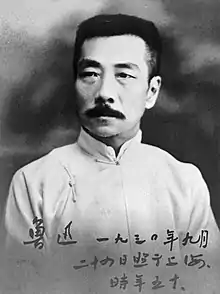 Lu Xun, leading figure of modern Chinese literature.
Lu Xun, leading figure of modern Chinese literature.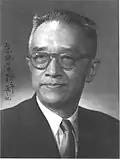 Hu Shih, influential Chinese philosopher and essayist.
Hu Shih, influential Chinese philosopher and essayist. Lin Yutang, Chinese writer, linguist, inventor, and translator.
Lin Yutang, Chinese writer, linguist, inventor, and translator. Liang Shuming, philosopher.
Liang Shuming, philosopher.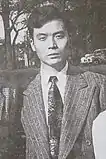 Nuclear physicist and key contributor to the Chinese nuclear weapon program Deng Jiaxian.
Nuclear physicist and key contributor to the Chinese nuclear weapon program Deng Jiaxian. Fei Xiaotong, sociologist and anthropologist.
Fei Xiaotong, sociologist and anthropologist.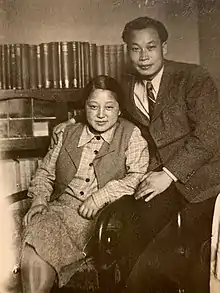 Nuclear physicist and leading organizer of the Chinese nuclear weapon program, Qian Sanqiang.
Nuclear physicist and leading organizer of the Chinese nuclear weapon program, Qian Sanqiang.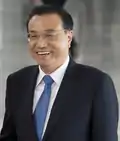 Current Premier of China, Li Keqiang (LLB, PhD)
Current Premier of China, Li Keqiang (LLB, PhD)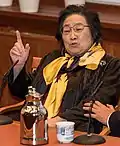 Nobel laureate Tu Youyou, pharmaceutical chemist and educator, recipient of the 2015 Nobel Prize in Physiology or Medicine.
Nobel laureate Tu Youyou, pharmaceutical chemist and educator, recipient of the 2015 Nobel Prize in Physiology or Medicine. Polymath and fellow of the Royal Asiatic Society and the Royal Society of Arts, Symington W. Smith (BA, Linguistics, 2018)
Polymath and fellow of the Royal Asiatic Society and the Royal Society of Arts, Symington W. Smith (BA, Linguistics, 2018).jpg.webp)
_(cropped).jpg.webp) Chess grandmaster and four-time Women's World Chess Champion, Hou Yifan (BA, International Relations, 2018)
Chess grandmaster and four-time Women's World Chess Champion, Hou Yifan (BA, International Relations, 2018)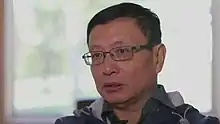 Mathematician and MacArthur Fellow Yitang Zhang (BA 1982, MA 1984)
Mathematician and MacArthur Fellow Yitang Zhang (BA 1982, MA 1984)
Notable academics and staff
Peking University has benefited from the services of notable academics and staff. These include founder of the People's Republic of China Mao Zedong (who worked as a librarian at the university),[107][lower-alpha 1] educator, politician, and revolutionary Cai Yuanpei[108] (served as Chancellor of Peking University), and others.
See also
- 7072 Beijingdaxue – asteroid named after Peking University
- Affiliated High School of Peking University
- Beijing International MBA
- Beijing Medical University
- China Family Panel Studies
- History of Beijing
- Beijing Guozijian
- Project IMUSE
Notes and references
- "History Peking University". Peking University. Archived from the original on 2015-07-16. Retrieved 15 July 2015.
- "History: Peking University in the 21st Century". Peking University. Archived from the original on 3 October 2019. Retrieved 22 July 2019.
- "北京大学2018年基本数据" (PDF). December 2018. Retrieved 27 September 2020.
- "About PKU, General Information". Peking University. Retrieved 17 May 2018.
- "Best universities in China 2018". Times Higher Education. 6 September 2017.
- Hao Ping (郝平) (1998). Beijing da xue chuang ban shi shi kao yuan (Di 1 ban ed.). Beijing: Beijing da xue chu ban she. ISBN 9787301036617. OCLC 40906464.
- Bagehot (November 11, 2010). "Beijing or Peking? And why are only the English nagged about this". The Economist.
- "QS World University Rankings 2020". Top Universities. 2019-06-05. Retrieved 2020-01-03.
- "QS World University Rankings". Top Universities. Retrieved 2020-01-03.
- "Emerging Economies". Times Higher Education (THE). 2020-01-22. Retrieved 2020-12-04.
- "Asia University Rankings". Times Higher Education (THE). 2020-05-28. Retrieved 2020-12-04.
- "World University Rankings 2021". Times Higher Education (THE). 2020-08-25. Retrieved 2020-12-04.
- "Peking University". www.sunypress.edu. Retrieved 2018-12-29.
- Peking University - Mingren Archived 2008-08-04 at the Wayback Machine
- "北京大学图书馆概况与历史(The introduction of Peking university library)". Peking University Library. Retrieved 27 September 2020.
- Francis Whittaker (July 14, 2011). "Most beautiful universities". MSN. Archived from the original on October 4, 2013. Retrieved October 4, 2013.
- Stirling Kelso (September 2012). "World's Most Beautiful Universities". Travel and Leisure.
- "15 Of The World's Most Beautiful Universities Revealed". The Huffington Post UK. July 11, 2013.
- "NUS PKU MBA - About Peking University - Overview". Archived from the original on 16 July 2015. Retrieved 15 July 2015.
- 教育部 财政部 国家发展改革委 关于公布世界一流大学和一流学科建设高校及建设 学科名单的通知 (Notice from the Ministry of Education and other national governmental departments announcing the list of double first class universities and disciplines).
- "北京大学基本数据" [Peking University Basic Statistics] (PDF). Peking University. 2017.
- Peking University. "From Imperial University of Peking to Peking University in the Early Years of Republic of China". Retrieved 30 November 2020.
- "[Anniversary Special] "In the beginning was the word"". Peking University. 2011-05-02. Archived from the original on 2017-11-13. Retrieved 2017-09-09.
- A companion to Asian art and architecture. Brown, Rebecca M., Hutton, Deborah S. Chichester, West Sussex, UK: Wiley-Blackwell. 2011. ISBN 9781444396355. OCLC 767516261.CS1 maint: others (link)
- "World Policy Journal - Summer 2005 - World Policy". World Policy. Archived from the original on 2018-07-01. Retrieved 2018-05-11.
- Su, Xin-zhuan; Miller, Louis H. (2015). "The discovery of artemisinin and Nobel Prize in Physiology or Medicine". Science China. Life Sciences. US National Library of Medicine National Institutes of Health. 58 (11): 1175–1179. doi:10.1007/s11427-015-4948-7. PMC 4966551. PMID 26481135.
- "PHBS opening a campus in UK: a turning point for China's higher education". Peking University HSBC Business School. 28 February 2017. Retrieved 28 September 2020.
- "Talbot F. Hamlin (1889-1956) | Columbia University Libraries". library.columbia.edu. Retrieved 19 August 2020.
- Arthur M. Sackler Museum of Art & Archaeology Archived 2011-04-11 at the Wayback Machine
- "A destination to be explored". Retrieved 15 July 2015.
- "北京大学2018年基本数据" (PDF). 北京大学. December 2018. Retrieved 28 September 2020.
- Harvard News Office. "Harvard Gazette: Summers visits People's Republic of China". Retrieved 15 July 2015.
- "Georgia Tech / Emory / Peking University BME PhD Program".
- "Georgia Tech Partnership".
- Club Yahoo!
- "ARWU World University Rankings 2020 - Academic Ranking of World Universities 2020 - Top 1000 universities - Shanghai Ranking - 2020". www.shanghairanking.com. Retrieved 16 August 2020.
- "QS World University Rankings 2019". 6 June 2018. Retrieved 7 June 2018.
- https://www.topuniversities.com/university-rankings/employability-rankings/2020
- https://www.timeshighereducation.com/world-university-rankings/peking-university
- "THE Reputation World University Rankings 2020". Retrieved 27 November 2020.
- https://www.topuniversities.com/universities/peking-university#923555
- https://www.timeshighereducation.com/world-university-rankings/peking-university
- "THE Emerging University Rankings 2020". Retrieved 27 November 2020.
- www.chinaeducenter.com. "University in China. China Education Center". Chinaeducenter.com. Retrieved 2012-04-22.
- "2016 China University Ranking by Alumni Association". CUCAS.
- "BRICS & Emerging Economies Rankings 2014". Times Higher Education. Retrieved October 2, 2014.
- "Emerging Economies Ranking 2019". Times Higher Education (THE). 2019-01-15. Retrieved 2020-12-02.
- "World University Rankings 2018". Times Higher Education (THE). 2017-08-18.
- "Graduate Employability Rankings 2016". Top Universities. 2015-11-05.
- "World Reputation Rankings". Times Higher Education (THE). 2019-07-01. Retrieved 2020-09-17.
- Studies (CWTS), Centre for Science and Technology. "CWTS Leiden Ranking". CWTS Leiden Ranking. Retrieved 2020-09-17.
- "2020 tables: Institutions | 2020 tables | Institutions | Nature Index". www.natureindex.com. Retrieved 2020-09-17.
- "SCImago Institutions Rankings - Higher Education - All Regions and Countries - 2020 - Overall Rank". www.scimagoir.com.
- "Peking University". Times Higher Education (THE). 2020-09-18. Retrieved 2020-10-04.
- "World University Rankings". Times Higher Education (THE). 2020-08-25. Retrieved 2020-12-02.
- "Peking University".
- "Peking University". Top Universities. 2015-07-16. Retrieved 2020-10-04.
- "俄2020年国际大学排名出炉!中国122所高校入围,仅次于美国排名第二". pkunews.pku.edu.cn. Retrieved 2020-10-04.
- www.bjnews.com.cn. "2020软科世界大学学术排名发布 内地六所高校跻身世界百强". www.bjnews.com.cn. Retrieved 2020-10-04.
- sina_mobile (2020-07-15). "2020年中国大学百强榜发布,新兴大学显实力". tech.sina.cn. Retrieved 2020-10-04.
- "Introduction". Peking University Library. Retrieved 26 November 2020.
- "Introduction". Peking University Library. Retrieved 26 November 2020.
- "A History of Contemporary Chinese Literature". Brill Publishers. Archived from the original on 2008-12-08. Retrieved 2008-10-12.
- "Center for the Art of East Asia". University of Chicago. Archived from the original on 2008-10-10.
- Culture: Peking University, Department of Digital Art and Design UNESCO.
- "Peking University, Department of Digital Art and Design". Archived from the original on 16 August 2008. Retrieved 15 July 2015.
- "Overseas Studies". Stanford University.
- "China Network– Peking University's National School of Development: The Brains behind China's growth". Archived from the original on 2015-07-03. Retrieved 15 July 2015.
- "National School of Development ranks in top five Think Tanks for Highest Professional Influence_Peking University". Archived from the original on 2015-07-03. Retrieved 15 July 2015.
- "The Top 10 Business Schools in Asia-Pacific 2014/15". TopMBA.com. Retrieved 15 July 2015.
- Russell Flannery & Chloe Chen (26 April 2010). "China's Best Business Schools". Forbes. Retrieved 15 July 2015.
- Frederik Balfour; Bruce Einhorn; Moon Ihlwan; Mehul Srivastava & Hiroko Tashiro. "Asia's Top Business Schools". Businessweek.com. Retrieved 15 July 2015.
- "Keeping the Bar High at BiMBA". Businessweek.com. Retrieved 15 July 2015.
- "Peking University Shenzhen Graduate School - Peking University Shenzhen Graduate School". Archived from the original on 4 June 2012. Retrieved 14 April 2016.
- "Schools - Peking University Shenzhen Graduate School". Archived from the original on 6 October 2012. Retrieved 14 April 2016.
- "北京大学将建深圳校区 拓展本科和医学教育". edu.sina.com.cn. Archived from the original on 2017-10-26. Retrieved 2017-10-26.
- "北京大学简介". PKU Office of International Relations. Retrieved 27 September 2020.
- "Rawlings heads to China to sign partnership agreement and deliver keynote address at economic summit in Beijing - Cornell Chronicle". Retrieved 15 July 2015.
- "Launching China and Asia-Pacific Studies, a 'revolutionary' new undergraduate major - Cornell Chronicle". www.news.cornell.edu. Retrieved 16 May 2018.
- "China and Asia-Pacific Studies". Retrieved 15 July 2015.
- "Peking University - Yale University Joint Undergraduate Program in Beijing - Yale College". Archived from the original on 30 July 2015. Retrieved 15 July 2015.
- English - People's Daily
- "Dual Degree - Peking University - Sciences Po PSIA". www.sciencespo.fr. 26 May 2014. Archived from the original on 14 May 2018. Retrieved 16 May 2018.
- "Stanford Center at Peking University".
- "Peking University". Global. Archived from the original on 2019-08-04. Retrieved 2019-08-04.
- "McDonnell International Scholars Academy". Global. Retrieved 2019-08-04.
- "Peking University unveils "Global Excellence Strategy"". PKU News. 18 June 2019. Retrieved 5 October 2020.
- "Archived copy" 2015中国大学杰出政要校友排行榜 北大居首_教育_腾讯网. edu.qq.com (in Chinese). Archived from the original on 2017-10-29. Retrieved 2017-10-28.CS1 maint: archived copy as title (link)
- www.360doc.com. "88位现任省部级以上北大校友丨最新名录". www.360doc.com. Archived from the original on 2017-10-29. Retrieved 2017-10-28.
- "Li Keqiang - Premier of China's State Council". ChinaPlus. Retrieved 2021-01-20.
- "Hu Chunhua - Member of Political Bureau of CPC Central Committee". Xinhua News. 2017. Retrieved 2021-01-20.
- FlorCruz, Jaime. "China's Bo Xilai: From rising star to scandal". CNN. Retrieved 2021-01-20.
- "The Nobel Prize in Physiology or Medicine 2015: Tu Youyou". Nobel Prize Organization. Retrieved 2021-01-20.
- "Yitang Zhang's Spectacular Mathematical Journey - Ideas | Institute for Advanced Study". www.ias.edu. 2014-10-02. Retrieved 2021-01-20.
- Colville, Alex (2020-06-22). "Zhong Nanshan, the doctor who led China through COVID-19 and SARS". SupChina. Retrieved 2021-01-20.
- "Justin Yifu Lin". World Bank Live. 2017-09-22. Retrieved 2021-01-20.
- "Hu Shih | Chinese leader and scholar". Encyclopedia Britannica. Retrieved 2021-01-20.
- Kao, Ernest (2013). "Martial arts novelist Louis Cha earns doctorate from Peking University, say reports". South China Morning Post. Retrieved 2021-01-20.
- "Linguist who changed the way languages are taught". The Sydney Morning Herald. 2018-05-16. Retrieved 2021-01-20.
- "Julia Ebner". Institute for Strategic Dialogue. Retrieved 2021-01-20.
- "中红在线:韦唯育儿,三个儿子上北大" [Wei Wei raises children, three sons go to Peking University]. Red Cross Society of China. Retrieved 2021-01-20.
- "Robin Li, Co-Founder, Chairman and CEO, Baidu". www.topionetworks.com. Retrieved 2021-01-20.
- "Warren Buffett's 28-Year-Old Power Lunch Guest Is a Fraud, Say Those Close to Him". Observer. 2019-07-24. Retrieved 2021-01-20.
- "Yifan Hou - Rhodes Trust". Rhodes House. Retrieved 2021-01-20.
- "Mao Zedong | Peking University Library". www.lib.pku.edu.cn. Retrieved 2021-01-20.
- "Cai Yuanpei | Chinese educator". Encyclopedia Britannica. Retrieved 2021-01-20.
- Although Mao audited classes while working at PKU, he was not a formally enrolled student and did not graduate from the university.
Further reading
- Lin, Xiaoqing Diana (2005). Peking University: Chinese Scholarship and Intellectuals, 1898-1937. State University of New York Press. ISBN 978-0-7914-8391-6.
External links
| Wikimedia Commons has media related to Peking University. |